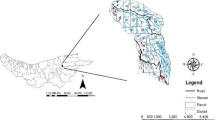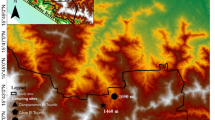Abstract
Little is recently known about the patterns of diversity of moths and their relationship with spatial parameters in the Hyrcanian forests of northern Iran. We selected mixed coniferous and broad-leaved forest (MCBF) (less than 400 m), Persian ironwood-common hornbeam forest (PCF) (between 400 and 650 m) and beech forest (BF) (between 650 and 900 m) for sampling the moth assemblages in a temperate deciduous forest of northern Iran to enhance these current knowledge gaps. Light trapping yielded a total of 474 moths representing 84 species. A significant correlation was found between the total number of species and elevational distribution. In general, the dominant species were: Idaea sp. (20.22%), Arctia villica (13.73%) and P. rhomboidaria (12.8%) at less than 400 m, between 400 and 650 m, and between 650 and 900 m, respectively. Overall abundance, species richness, Fisher's α, and turnover rate indices followed the hump-shaped distribution pattern with an increase in altitude. The changes in moth assemblages presented with increasing elevation support our hypothesis that these trends are associated with variations in environmental conditions experienced with increasing altitude in the different forest types. Our results show that vegetation heterogeneity of a forest is the main key to moth richness, assemblage composition, and relative abundance.








Similar content being viewed by others
References
Acharya BK, Vijayan L (2015) Butterfly diversity along the elevation gradient of Eastern Himalaya, India. Ecol Res 30:909–919. https://doi.org/10.1007/s11284-015-1292-0
Acharya BK, Sanders N, Vijayan L, Chettri B (2011) Elevational gradients in bird diversity in the Eastern Himalaya: an evaluation of distribution patterns and their underlying mechanisms. PLoS ONE 16:e29097. https://doi.org/10.1371/journal.pone.0029097
Axmacher JC, Tünte H, Schrumpf M, Müller-Hohenstein K, Lyaruu HVM, Fiedler K (2004) Diverging diversity patterns of vascular plants and geometrid moths during forest regeneration on Mt Kilimanjaro, Tanzania. J Biogeogr 31:895–904. https://doi.org/10.1111/j.1365-2699.2004.00995.x
Aynekulu E, Aerts R, Moonen P, Denich M, Gebrehiwot K, Vagen TG, Mekuria W, Boehmer HJ (2012) Altitudinal variation and conservation priorities of vegetation along the Great Rift Valley escarpment, northern Ethiopia. Biodivers Conserv 21:2691–2707. https://doi.org/10.1007/s10531-012-0328-9
Beck J, Chey VK (2008) Explaining the elevational diversity pattern of geometrid moths from Borneo: a test of five hypotheses. J Biogeogr 35:1452–1464. https://doi.org/10.1111/j.1365-2699.2008.01886.x
Beck J, McCain CM, Axmacher JC, Ashton L, Bärtschi F, Brehm G, Choi SW, Cizek O, Colwell RK, Fiedler K, Francois CL, Highland S, Holloway JD, Intachat J, Kadlec T, Kitching RL, Maunsell SC, Merckx T, Nakamura A, Odell E, Sang W, Toko PS, Zamecnik J, Zou Y, Novotny V (2017) Elevational species richness gradients in a hyperdiverse insect taxon: a global meta-study on geometrid moths. Glob Ecol Biogeogr 26:412–424. https://doi.org/10.1111/geb.12548
Bishop TR, Robertson MP, van-Rensburg BJ, Parr CL (2015) Contrasting species and functional beta diversity in montane ant assemblages. J Biogeogr 42:1776–1786. https://doi.org/10.1111/jbi.12537
Brehm G, Süssenbach D, Fiedler K (2003) Unique elevational diversity patterns of geometrid moths in an Andean montane rainforest. Ecography 26:456–466
Brehm G, Colwell RK, Kluge J (2007) The role of environment and mid-domain effect on moth species richness along a tropical elevational gradient. Glob Ecol Biogeogr 16:205–219. https://doi.org/10.1111/j.1466-8238.2006.00281.x
Brown JH (1984) On the relationship between abundance and distribution of species. Am Nat 124:255–279. https://doi.org/10.1086/284267
Brown JH, Stevens GC, Kaufman DM (1996) The geographic range: size, shape, boundaries, and internal structure. Annu Rev Ecol Evol Syst 27:597–623. https://doi.org/10.1146/annurev.ecolsys.27.1.597
Casson DS, Hodkinson ID (1991) The Hemiptera (Insecta) communities of tropical rain forest in Sulawesi. Zool J Linnean Soc 102:253–275. https://doi.org/10.1111/j.1096-3642.1991.tb00002.x
Chen YB, Hou GZ, Meng QL, Ai G, Meng G, Gao WT (2007) On vertical distribution and fauna of the geometrid moth in Changbai Mountain. J Beihua Univ 8(73):79
Claridge MF, Singrao JS (1978) Diversity and altitudinal distribution of grasshoppers (Acridoidea) on a Mediterranean mountain. J Biogeogr 5:239–250. https://doi.org/10.2307/3038039
da Silva PG, Lobo JM, Hensen MC, Vaz-de-Mello FZ, Hernandez MIM (2018) Turnover and nestedness in subtropical dung beetle assemblages along an elevational gradient. Divers Distrib 24:1277–1290. https://doi.org/10.1111/ddi.12763
Fargione J, Tilman D, Dybzinski R, Lambers JHR, Clark C, Harpole WS, Knops JMH, Reich PB, Loreau M (2007) From selection to complementarity: shifts in the causes of biodiversity-productivity relationships in a long-term biodiversity experiment. Proc Royal Soc B Biol Sci 274:871–876. https://doi.org/10.1098/rspb.2006.0351
Ferro VG, Romanowski HP (2012) Diversity and composition of tiger moths (Lepidoptera: Arctiidae) in an area of Atlantic Forest in southern Brazil: is the fauna more diverse in the grassland or in the forest. Rev Bras Zool 29:7–18. https://doi.org/10.1590/S1984-46702012000100002
Fleishman E (2010) Understanding species richness gradients informs projected responses to climate change. J Biogeogr 37:1175–1176. https://doi.org/10.1111/j.1365-2699.2010.02316.x
Fontana V, Guariento E, Hilpold A, Niedrist G, Steinwandter M, Spitale D, Nascimbene J, Tappeiner U, Seeber J (2020) Species richness and beta diversity patterns of multiple taxa along an elevational gradient in pastured grasslands in the European Alps. Sci Rep 10:12516. https://doi.org/10.1038/s41598-020-69569-9
Hajizadeh G, Jalilvand H, Kavosi MR, Barimani Varandi H (2022) Seasonal Patterns in Moth Abundance and Species Diversity in the Northern Mountainous Forests of Iran. Proc Natl Acad Sci India Sect B Biol Sci 92:149–156. https://doi.org/10.1007/s40011-021-01304-4
Hodkinson ID (2005) Terrestrial insects along elevation gradients: species and community responses to altitude. Biol Rev 80:489–513. https://doi.org/10.1017/S1464793105006767
Janzen DH, Ataroff M, Fariñas M, Reyes S, Rincon N, Soler A, Soriano P, Vera M (1976) Changes in the arthropod community along an elevational transect in the Venezuelan Andes. Biotropica 8:193–203. https://doi.org/10.2307/2989685
Koh CN, Lee PF, Wu SH (2006) Does the distribution of breeding bird species richness in Taiwan follow the mid-domain effect? Taiwania 51:108–116
Lasmar CJ, Ribas CR, Louzada J, Queiroz ACM, Feitosa RM, Imata MMG, Alves G, Nascimento GB, Neves FS, Domingos DQ (2020) Disentangling elevational and vegetational effects on ant diversity patterns. Acta Oecol 102:103489. https://doi.org/10.1016/j.actao.2019.103489
Liu SD, Meng QF, Gao WT (2007) Moth diversity in the northern slope of Changbai mountain nature reserve. J Northeast for Univ 35:51–53
Machac A, Janda M, Dunn RR, Sanders NJ (2011) Elevational gradients in phylogenetic structure of ant communities reveal the interplay of biotic and abiotic constraints on diversity. Ecography 34:364–371. https://doi.org/10.1111/j.1600-0587.2010.06629.x
Merckx T, Feber RE, Riordan P, Townsend MC, Bourn NAD, Parsons MS, Macdonald DW (2009) Optimizing the biodiversity gain from agri-environment schemes. Agric Ecosyst Environ 130:177–182. https://doi.org/10.1016/j.agee.2009.01.006
Müller J, Varandi H, Babaii M, Farashiani ME, Sageb-Talebi K, Lange F, Gossner MM, Jarzabek-Müller A, Roth N, Thorn S, Seibold S (2018) The diversity of saproxylic insects (Coleoptera, Heteroptera) on four tree species of the Hyrcanian forest in Iran. J Insect Conserv 22:607–625. https://doi.org/10.1007/s10841-018-0089-1
Nor S (2001) Elevational diversity patterns of small mammals on Mount Kinabalu, Sabah, Malaysia. Glob Ecol Biogeogr 10:41–62. https://doi.org/10.1046/j.1466-822x.2001.00231.x
Novillo A, Ojeda RA (2014) Elevation patterns in rodent diversity in the dry Andes: disentangling the role of environmental factors. J Mammal 95:99–107. https://doi.org/10.1644/13-MAMM-A-086.1
Oxbrough A, French V, Irwin S, Kelly TC, Smiddy P, O’Halloran J (2012) Can mixed species stands enhance arthropod diversity in plantation forests? For Ecol Manag 270:11–18. https://doi.org/10.1016/j.foreco.2012.01.006
Özdemir M (2019) Habitat preference of Geometridae species in western black sea region of Turkey (Lepidoptera: Geometridae). SHIL Rev Lepidopterol 47:673–684
Paknia O, Rajaei H (2015) Geographical patterns of species richness and beta diversity of Larentiinae moths (Lepidoptera: Geometridae) in two temperate biodiversity hotspots. J Insect Conserv 19:729–739. https://doi.org/10.1007/s10841-015-9795-0
Perillo LN, Neves FS, Antonini Y, Martins RP (2017) Compositional changes in bee and wasp communities along Neotropical mountain altitudinal gradient. PLoS ONE 12:e0182054. https://doi.org/10.1371/journal.pone.0182054
Price PW (1997) Insect Ecology, 3rd edn. John Wiley and Sons, New York
Rabieh MM (2018) Biodiversity of noctuid moths (Lepidoptera: Noctuidae) in the agroecosystems of Mashhad County. Biodivers Int J 2:147–151. https://doi.org/10.15406/bij.2018.02.00057
Rahbek C (1997) The relationship among area, elevation, and regional species richness in neotropical birds. Am Nat 149:875–902. https://doi.org/10.1086/286028
Romdal TS, Grytnes JA (2007) An indirect area effect on elevational species richness patterns. Ecography 30:440–448. https://doi.org/10.1111/J.2007.0906-7590.04954.x
Rosenzweig ML (1995) Species Diversity in Space and Time. Cambridge University, UK
Sagheb-Talebi K, Sajedi T, Pourhashemi M (2014) Plant and vegetation: Forests of Iran—a treasure from the past, a hope for the future. Springer, Dordrecht
Salomão RP, Arriaga-Jiménez A, Kohlmann B (2021) The relationship between altitudinal gradients, diversity, and body size in a dung beetle (Coleoptera: Scarabaeinae: Onthophagus) model system. Can J Zool 99:33–43. https://doi.org/10.1139/cjz-2020-0072
Schuldt A, Assmann T (2011) Belowground carabid beetle diversity in the western Palaearctic–effects of history and climate on range-restricted taxa (Coleoptera, Carabidae). Zookeys 100:461–474. https://doi.org/10.3897/zookeys.100.1540
Soininen J, Heino J, Wang J (2018) A meta-analysis of nestedness and turnover components of beta diversity across organisms and ecosystems. Glob Ecol Biogeogr 27:96–109. https://doi.org/10.1111/geb.12660
Sun X, Deharveng L, Bedos A, Chang L, Scheu S, Wu D (2020) Changes in diversity and body size of Onychiurinae (Collembola: Onychiuridae) along an altitudinal gradient in Changbai mountain, China. Soil Ecol Lett 2:230–239. https://doi.org/10.1007/s42832-020-0040-8
Terborgh J (1971) Distribution on environmental gradients: theory and a preliminary interpretation of distributional patterns in the avifauna of the Cordillera Vilcabamba, Peru. Ecol 52:23–40. https://doi.org/10.2307/1934735
Zou Y, Sang W, Zhou H, Huang L, Axmacher JC (2014) Altitudinal diversity patterns of ground beetles (Coleoptera: Carabidae) in the forests of Changbai Mountain, Northeast China. Insect Conserv Divers 7:161–171. https://doi.org/10.1111/icad.12039
Acknowledgements
We would like to express our sincerely appreciation to Dr. Rajaei (State Museum of Natural History Stuttgart, Germany) for identification of the moth species. Undoubtedly, we would not have been able to complete our research without help from him. We are also grateful to Dr. Soofi (Georg August University Göttingen, Germany) and Abolfazl Asadi (Sari Agricultural Sciences and Natural Resources University, Iran) for their kind cooperation in this research. We finally would like to thank unknown reviewers for their comments on an earlier version of this manuscript, which helped greatly in improving the text. All moth samplings have been done with the official permissions from natural conservation organization. This paper is part of the PhD project of Goodarz Hajizadeh at the Sari Agricultural Sciences and Natural Resources University.
Funding
This research received no external funding.
Author information
Authors and Affiliations
Contributions
Conceptualization, G.H., H.J., M.R.K., H.B.V.; methodology, G.H., H.J., M.R.K., H.B.V.; formal analysis, G.H., H.J.; Sampling, G.H.; writing—original draft preparation, G.H.; All the authors have visualized and reviewed the manuscript.
Corresponding author
Ethics declarations
Competing interests
The authors have no competing interests to declare that are relevant to the content of this article.
Additional information
Publisher's Note
Springer Nature remains neutral with regard to jurisdictional claims in published maps and institutional affiliations.
Rights and permissions
Springer Nature or its licensor (e.g. a society or other partner) holds exclusive rights to this article under a publishing agreement with the author(s) or other rightsholder(s); author self-archiving of the accepted manuscript version of this article is solely governed by the terms of such publishing agreement and applicable law.
About this article
Cite this article
Hajizadeh, G., Jalilvand, H., Kavosi, M.R. et al. Altitudinal diversity patterns of moths in a temperate deciduous forest of Northern Iran. Int J Trop Insect Sci 42, 3821–3829 (2022). https://doi.org/10.1007/s42690-022-00908-1
Received:
Accepted:
Published:
Issue Date:
DOI: https://doi.org/10.1007/s42690-022-00908-1




